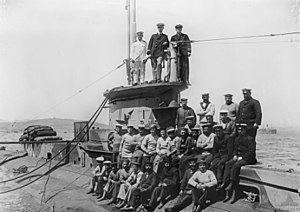Name HMS E14 Laid down 14 December 1912 Fate Sunk, 28 January 1918 Length 55 m | Cost £105,700 Commissioned 18 November 1914 Construction started 14 December 1912 | |
 | ||
Builders Vickers Limited, Barrow-in-Furness | ||
HMS E14 was a British E class submarine built by Vickers, Barrow-in-Furness. During the First World War, two of her captains were awarded the Victoria Cross, and a large number of her officers and men also decorated. HMS E14 was laid down on 14 December 1912 and was commissioned on 18 November 1914. Her hull cost £105,700. She was sunk by shellfire from coastal batteries in the Dardanelles on 28 January 1918.
Contents
Design
Like all post-E8 British E-class submarines, E14 had a displacement of 662 tonnes (730 short tons) at the surface and 807 tonnes (890 short tons) while submerged. She had a total length of 180 feet (55 m) and a beam length of 22 feet 8.5 inches (6.922 m). She was powered by two 800 horsepower (600 kW) Vickers eight-cylinder two-stroke diesel engines and two 420 horsepower (310 kW) electric motors. The submarine had a maximum surface speed of 16 knots (30 km/h; 18 mph) and a submerged speed of 10 knots (19 km/h; 12 mph). British E-class submarines had fuel capacities of 50 tonnes (55 short tons) of diesel and ranges of 3,255 miles (5,238 km; 2,829 nmi) when travelling at 10 knots (19 km/h; 12 mph). E14 was capable of operating submerged for five hours when travelling at 5 knots (9.3 km/h; 5.8 mph).
As with most of the early E class boats, E14 was not fitted with a deck gun during construction, but later had a single 6-pounder QF gun mounted forward of the conning tower at Malta dockyard. She had five 18 inches (460 mm) torpedo tubes, two in the bow, one either side amidships, and one in the stern; a total of 10 torpedoes were carried.
E-Class submarines had wireless systems with 1 kilowatt (1.3 hp) power ratings; in some submarines, these were later upgraded to 3 kilowatts (4.0 hp) systems by removing a midship torpedo tube. Their maximum design depth was 100 feet (30 m) although in service some reached depths of below 200 feet (61 m). Some submarines contained Fessenden oscillator systems.
Crew
Her complement was three officers and 28 men.
Service history
E14 took part in an operation to penetrate the Sea of Marmara. She successfully dived beneath the minefields and broke into the Sea of Marmara on 27 April 1915. She quickly sank the Turkish gunboat Nurel Bahr, sinking 200 tons on 1 May. She then went on to damage the minelayer Peik I Shevket sinking 1014 tons in a torpedo attack. On 3 May she torpedoed transportship Gul Djemal with 4,000 soldiers on board.
Upon her return, her captain, Lieutenant Commander Edward Courtney Boyle received the Victoria Cross; Lieutenant Edward Geldard Stanley and Acting Lieutenant Reginald Wilfred Lawrence were both awarded the Distinguished Service Cross and all the ratings were awarded the Distinguished Service Medal.
Later in her career, her new captain, Lieutenant Commander Geoffrey Saxton White was posthumously awarded the Victoria Cross for his actions in the Dardanelles. With the ex-Goeben crippled after the Battle of Imbros, E14 was dispatched to finish off the Turkish battlecruiser when repeated air attacks failed to destroy her.
Finding the Goeben gone, E14 attacked a merchant ship as she withdrew from the Dardanelles. Firing two torpedoes, one prematurely exploded damaging the submarine. She was forced to surface because of flooding but then came under coastal battery fire off Kum Kale.
Then, while attempting to beach safely, White was killed by shellfire. E14 sank, but nine of her crew survived and were taken prisoner.
Wreck
In June 2012, after a three-year search, Turkish marine engineer Selçuk Kolay and filmmaker Savas Karakas discovered the wreck of E14 in 20 m of water about 250 m off Kum Kale.
The boat is largely buried in sand, only 7 m of the coral-encrusted bow, with a shell hole, remaining visible. The British government is to ask the Turkish authorities to ensure the wreck is respected as a war grave. [1]
